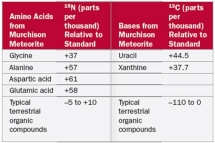Multiple Choice
Which of the following conclusions can be made from Table 2.7? 
A) Glycine is a more abundant amino acid in the meteorite than in terrestrial samples
B) 15N is more abundant in amino acids from the meteorite than from terrestrial samples
C) Amino acids in the meteorite contain more nitrogen than amino acids from terrestrial samples
D) 13C is more abundant in amino acids from the meteorite than from terrestrial samples
E) Uracil is a more abundant amino acid in the meteorite than in terrestrial samples
Correct Answer:

Verified
Correct Answer:
Verified
Q19: Organic molecules are defined as chemical compounds
Q20: If ice were more dense than water,then
Q21: Evaporation is:<br>A)The conversion of a liquid into
Q22: <sup>14</sup>C and <sup>14</sup>N are both:<br>A)Atoms<br>B)Molecules<br>C)Compounds<br>D)Polymers<br>E)Ions
Q23: The polymers with the most complex and
Q25: The most common isotope of carbon is
Q26: In the example of ionic bond formation
Q27: The four nitrogen bases found in RNA
Q28: The primary elements making up living organisms
Q29: In Table 2.7 why were amino acids